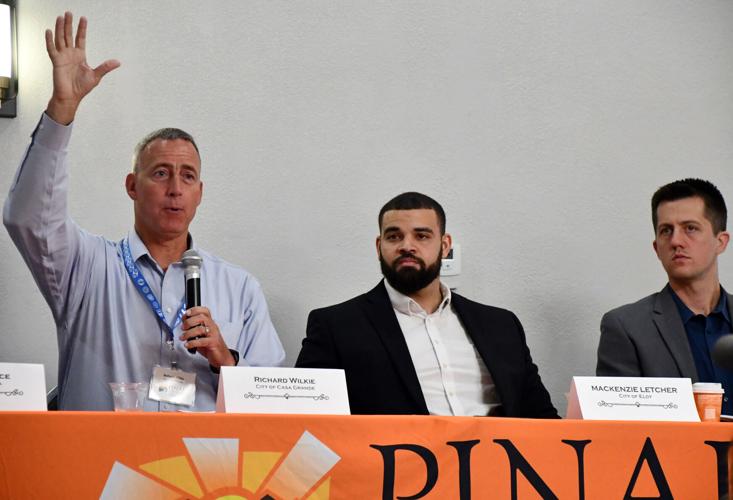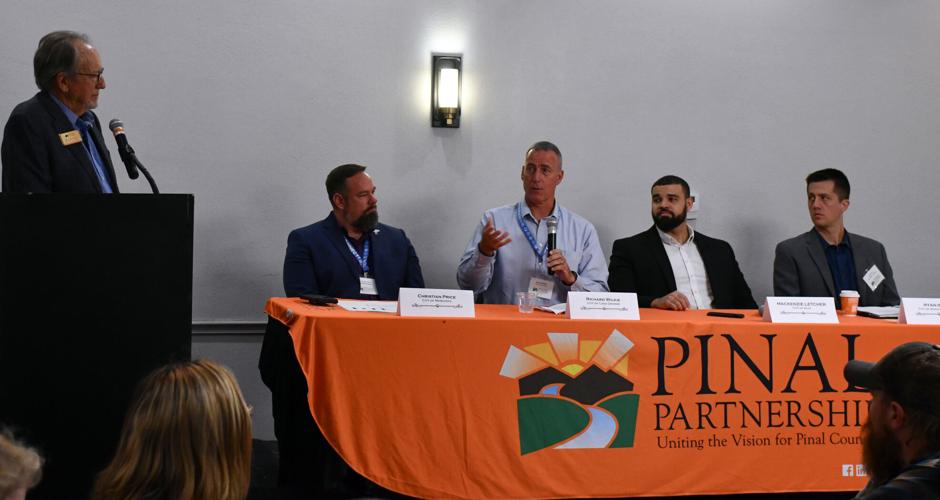CASA GRANDE — A panel of economic developers from within Pinal County told attendees at a Pinal Partnership breakfast that continued growth in the county has created a significant challenge: the need for more infrastructure as they seek to entice more companies to the region.
The panel discussion was held Friday at the Radisson Hotel and was moderated by former Pinal Partnership President and CEO Harold Christ. Participating in the discussion were Richard Wilkie, economic development director for Casa Grande; Ryan Kaup, economic development director for Apache Junction; Mackenzie Letcher, assistant city manager for Eloy; and Christian Price, economic growth officer for Maricopa. In the audience listening to the panel was U.S. Rep. Juan Ciscomani, R-Tucson.
Christ asked panel members what they thought were the biggest challenges facing them, and the recurring theme was a need for more infrastructure, such as roads, sewer systems and utility infrastructure.
Wilkie said it is a constant challenge for the city to keep up with demand and emphasized the importance of maintaining good relationships between cities and utility companies, which he noted already exists in Casa Grande.
“I think one of the biggest topics that every economic development manager, director of any city is faced with these days is trying to maintain that utility infrastructure,” said Wilkie, who added it is a never-ending battle to stay ahead of providing utility infrastructure.
“We’ve done a very good job, thanks to the leadership of our city manager, our mayor and our council. We’re always working with our great (utility) partners, APS, Arizona Water and Southwest Gas. You have to have that collaboration to really kind of push forward with the utilities because without the utilities, development doesn’t come easy.”
Letcher said the biggest infrastructure issue facing Eloy is a lack of housing and that more houses need to be built to meet the demand created by the influx of businesses moving into Pinal County
“I think we’re struggling with an issue that I believe most of the communities here in Pinal County and probably across the state are dealing with and it’s housing. Whether that’s availability of housing, workforce housing, the affordability of housing and the diversity, we’re struggling with it all,” said Letcher, who said he is concerned that if it is not available, potential residents may seek housing elsewhere.
“I think we’re at a pretty close tipping point in Eloy, because look how competitive Pinal County is as a region with our access to the Interstate 8 and 10. We’re growing exponentially when it comes to workforce growth and being able to attract and bring industries into our communities. As it stands right now, we don’t have the workforce housing. Much as I love Casa Grande, the majority of our workers are gonna be living in Casa Grande, living in Maricopa or worse yet they’re going to be going up to Maricopa County or Pima County, and that hurts everybody in this room.”
Kaup said in Apache Junction’s instance housing is booming and that the city is experiencing rapid population growth.
“From Apache Junction’s standpoint we have had some great wins on the housing growth, which is new for Apache Junction. Just a few years ago we were averaging 100 single-family permits per year. We’re now at 1,000, so that’s significant growth for us. We’re at almost 8% annual population growth.”
Christ asked Price what are the key selling points that cities use in attracting new business.
“There’s a lot that goes into economic development. It is not cut and dry, easy or simple,” Price said. “You never know what is going to convince that board or CEO that that is the place they want to be. Sometimes it’s workforce, sometimes it’s incentives, sometimes it’s the ease of dealing with a city. We’re finding that when the developer or a company goes in and feels like they’re getting nickel and dimed and red taped to death they don’t want to be there. We’ve had lots of folks talk to us about how they really enjoy that. We try and run parallel permitting processes and we try and do things as easy as possible.”
Ciscomani, who was not part of the panel discussion, said it was of great benefit to be able to simply listen in and gain an informed snapshot of the economic health of Pinal County.
“This is one of the best ways that I can find out what’s going on across the county,” he said. “We heard about challenges, opportunities, victories that we’ve seen and obviously the economic development is a big part of it.”
























(0) comments
Welcome to the discussion.
Log In